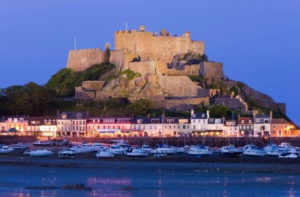JERSEY – THE CHANNEL ISLANDS
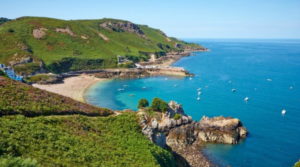
The largest of the Channel Islands, Jersey is just off the coast of Normandy, in the Bay of St Malo, and easily accessed from a couple of French ports, by direct ferry from Guernsey and from the UK. Only 8 kms long and 14 kms wide, the long stretches of beautiful beaches and bays along its coast are never more than ten minutes away.

St Helier, the main town of the island, is a mid-Victorian town with numerous modern office buildings reflecting its role as the major business hub of the Channel Islands. You will find all the shops typical of an English provincial town, traditional British pubs, good quality accommodation and excellent food.
Jersey was once part of the Duchy of Normandy, whose dukes went on to become kings of England from 1066. After the English kings lost Normandy in the 13th century, the ducal title surrendered to France, but the Channel Islands remained attached to the British crown.
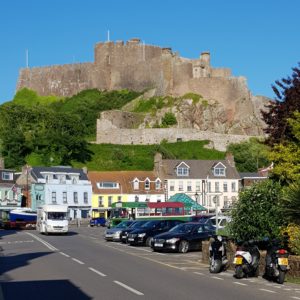
Reflecting its sometimes turbulent history, there are numerous castles on the island. Dramatically perched on a high cliff overlooking the charming port at Gorey, is the 13th century Mont Orgueil. One of the best-preserved castles in Britain, it was built to defend the island against a French invasion.
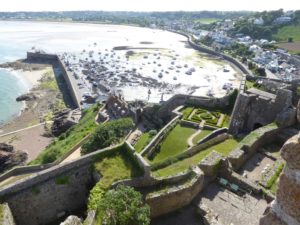
A relaxing and very pleasant way to get there is by the local bus from St Helier, which travels along picturesque hedgerowed lanes, lush green fields, lots of beautiful Jersey cows, small villages and pretty coastal scenery. The small town of Gorey has a number of traditional pubs with terrific seafood restaurants, the specialty being local lobster and other shellfish.
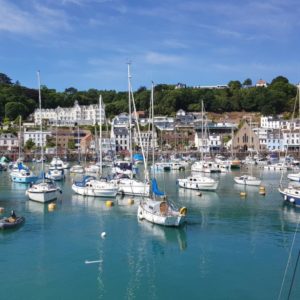
Also worth checking out is Elizabeth Castle and Hermitage at St Aubins Bay, built in the 1590s, and named by Sir Walter Raleigh after Queen Elizabeth l. In the 1640s the bailiff and governor of Jersey, Sir Charles Carteret, gave sanctuary at Elizabeth Castle to the exiled Charles, Prince of Wales, during the English Civil War. After his proclamation as King Charles the Second at the Castle, the grateful Charles handsomely rewarded the bailiff for his loyalty to the crown in defiance of Cromwell.
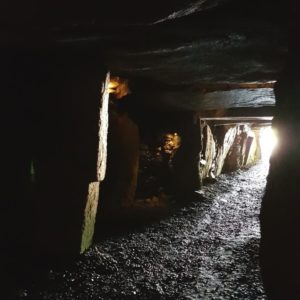
Jersey’s history can be traced back to the Neolithic period. One of the most memorable sites we visited on Jersey is La Hougue Bie at Grouville, a Neolithic burial mound dating back an estimated 6,000 years, and said to be one of the ten oldest buildings in the world. The tomb was first excavated in 1925, and it’s now possible to enter it, bent double, via a long, low passage. Once inside, it’s possible to stand in the chamber, which is quite an experience. Observations from inside the tomb at sunrise on the spring and autumn equinox have revealed that the orientation of the passage allows the sun’s rays to shine through to the chamber.
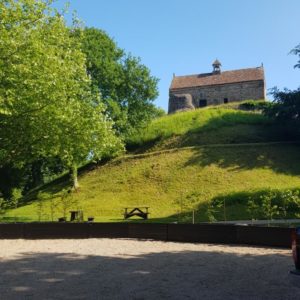
Somewhat incongruously, on top of the prehistoric mound is a 12th century chapel, Notre Dame de la Clarté, which was extended during the Victorian era to give it a more “picturesque” appearance! These very odd-looking additions have since been demolished.
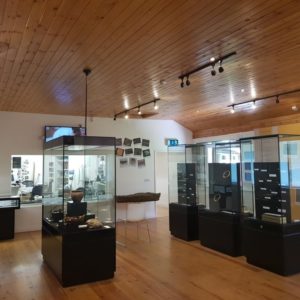
On display at the site is an extraordinary hoard of ancient treasure comprising coins and jewellery that had lain hidden for over 3,000 years, discovered in 2012 by two men using metal detectors in a nearby field. Regarded as the world’s largest Celtic coin hoard, visitors can watch conservators as they painstakingly work on even more coins, axes, swords and spears since unearthed from the hoard.
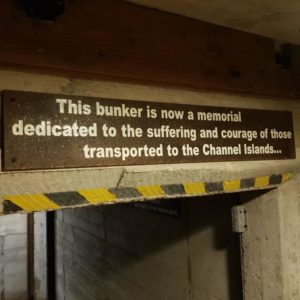
During WW2, the Hougue Bie mound was used as a key lookout point. There is also a command bunker constructed during the German Occupation, which now houses a unique memorial to the slave-workers who were brought to the Channel Islands by the Nazis during WW2. It’s worth purchasing a Jersey Heritage Pass which gives unlimited access to four must-see sites on Jersey for the price of three, which is valid for seven days.
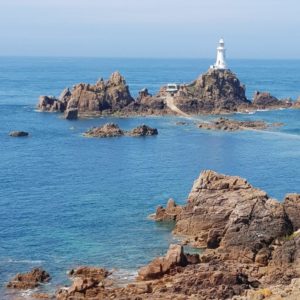
As with Guernsey, the island had long been fortified against invasion. Martello towers, some of which were modified by the Germans during the Occupation, and other fortifications are very prominent across the island.
We were aware of the island’s history of Occupation during WW2 and had made contact with an organisation called The Channel Islands Occupation Society (CIOS), which provided us with a lot of very useful information about visiting the various sites on the island that date from this period. Members are present at various sites on Sundays and available to answer questions and offer suggestions about visiting the various wartime sites scattered across Jersey, for those interested in this period of history.

There are numerous huge bunkers and gun emplacements, fortifications such as those at La Corbière and Batterie Moltke, the remnants of a rail network used for searchlights and observation towers, and multi-level defences such as that at Strongpoint Plémont.
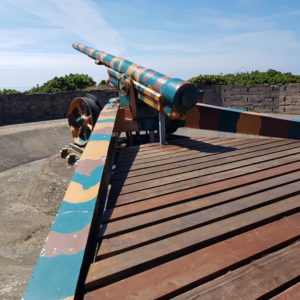
There’s also a huge gun emplacement at Batterie Lothringen which was the only German Naval batterie on Jersey. Many of these enormous guns were thrown off the cliffs after the war by the islanders, in an understandable attempt to rid the island of these reminders of the years of terrible privation and fear. In the 1990s CIOS recovered one of these guns from the seabed. It is now installed and on display at the very impressive Batterie Lothringen, where you can also see the Naval artillery direction and range-finding tower on top of the underground command bunker.
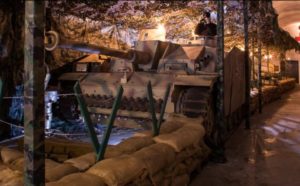
Like Guernsey, there is an extensive network of WW2 tunnels on the island at St Lawrence. Collectively referred to as the War Tunnels, they are open to visitors and the museum displays tell the story of the challenges of life in Jersey under the Occupation, acute food shortages, starvation and eventual liberation.
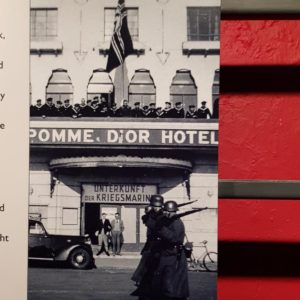
We discovered upon arrival in St Helier, that our hotel, the ‘Pomme d’Or’, overlooking St Helier port, had been used as the German Naval Headquarters during the Occupation. There are a number of very interesting photos of this period on view in the hotel.
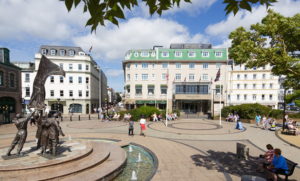
It seems only fitting that a large sculpture commemorating the liberation at the end of the war is situated at Liberation Place, directly opposite the Pomme d’Or.
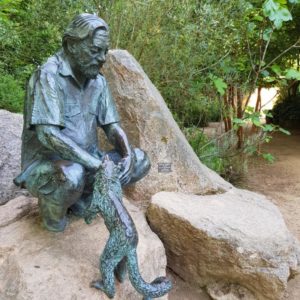
One of the many highlights of the island is the world-renowned Jersey Zoo. Established in 1959 by British writer, naturalist and conservationist Gerald Durrell of ‘My Family & Other Animals’, ‘A Zoo in My Luggage’ fame and so many other wonderful, witty and insightful books, too numerous to mention. Operated by the Durrell Wildlife Conservation Trust, the aim of the zoo from the outset was to be a reserve and breeding centre for endangered species.

Although the zoo is particularly associated with the gentle lemurs of Madagascar, the visitor can also see Golden lion and Emperor tamarins, Sumatran orangutans, numerous gorillas, meerkats, aye-ayes and other rare animals, birds and reptiles. The zoo’s setting is a 17th century manor house, Les Augres Manor.
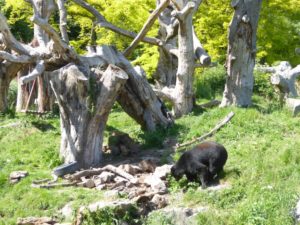
The 32 ha. park is divided into segments for over 130 rare and endangered species, in as natural and open an environment as possible, so that the animals can roam as freely as possible. The beautiful grounds have seen extensive planting of flowering and fruiting trees which serve to attract a plethora of wild birds and insects.
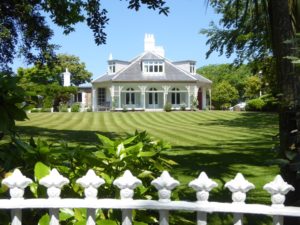
It’s easy to fill many very pleasant days exploring the fascinating history of Jersey, and perhaps pay a visit to a winery, distillery and cider farm, indulge in the very best seafood, wander through wooded valleys and country lanes, or simply relaxing on one of the many beautiful beaches.
